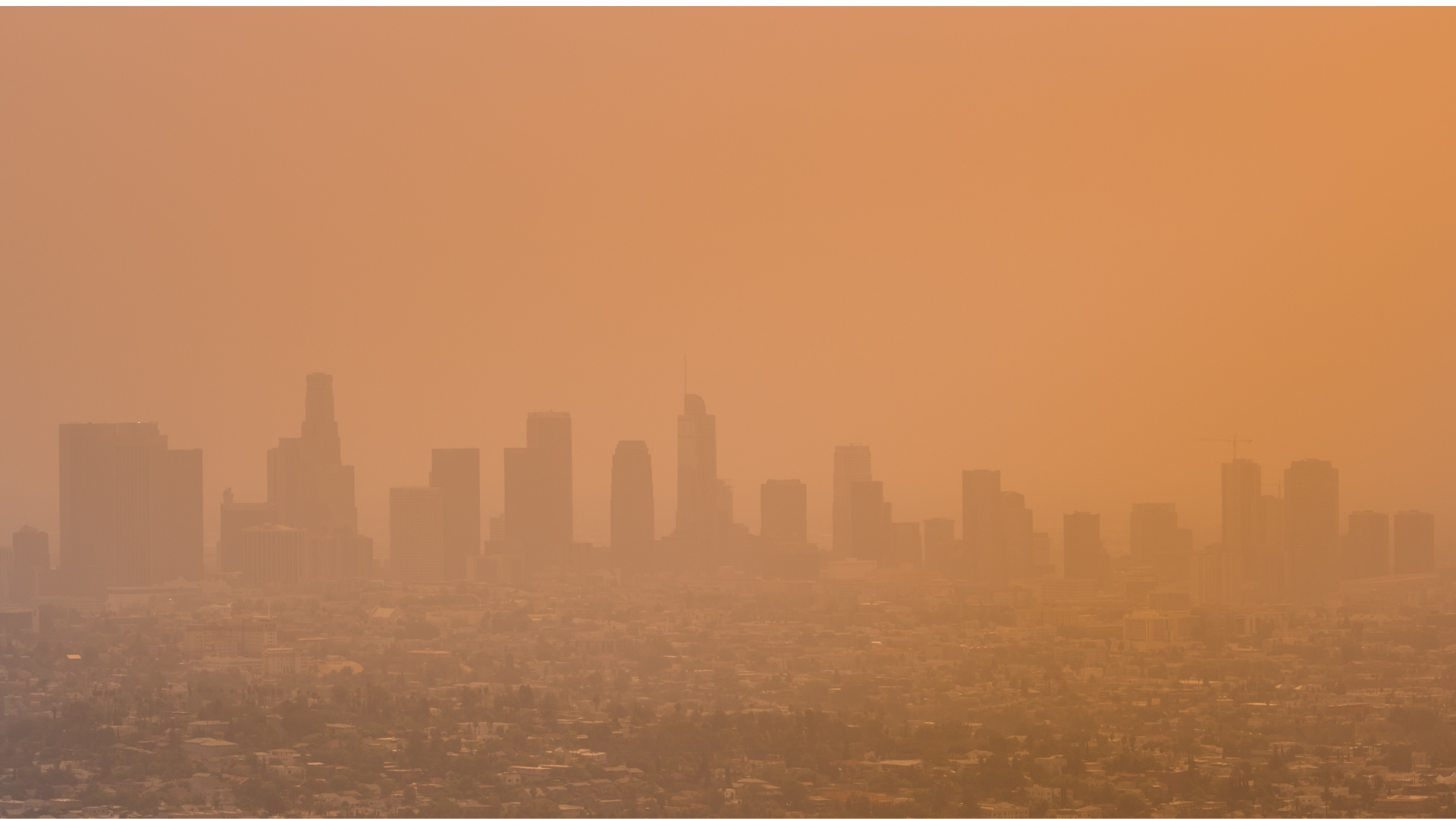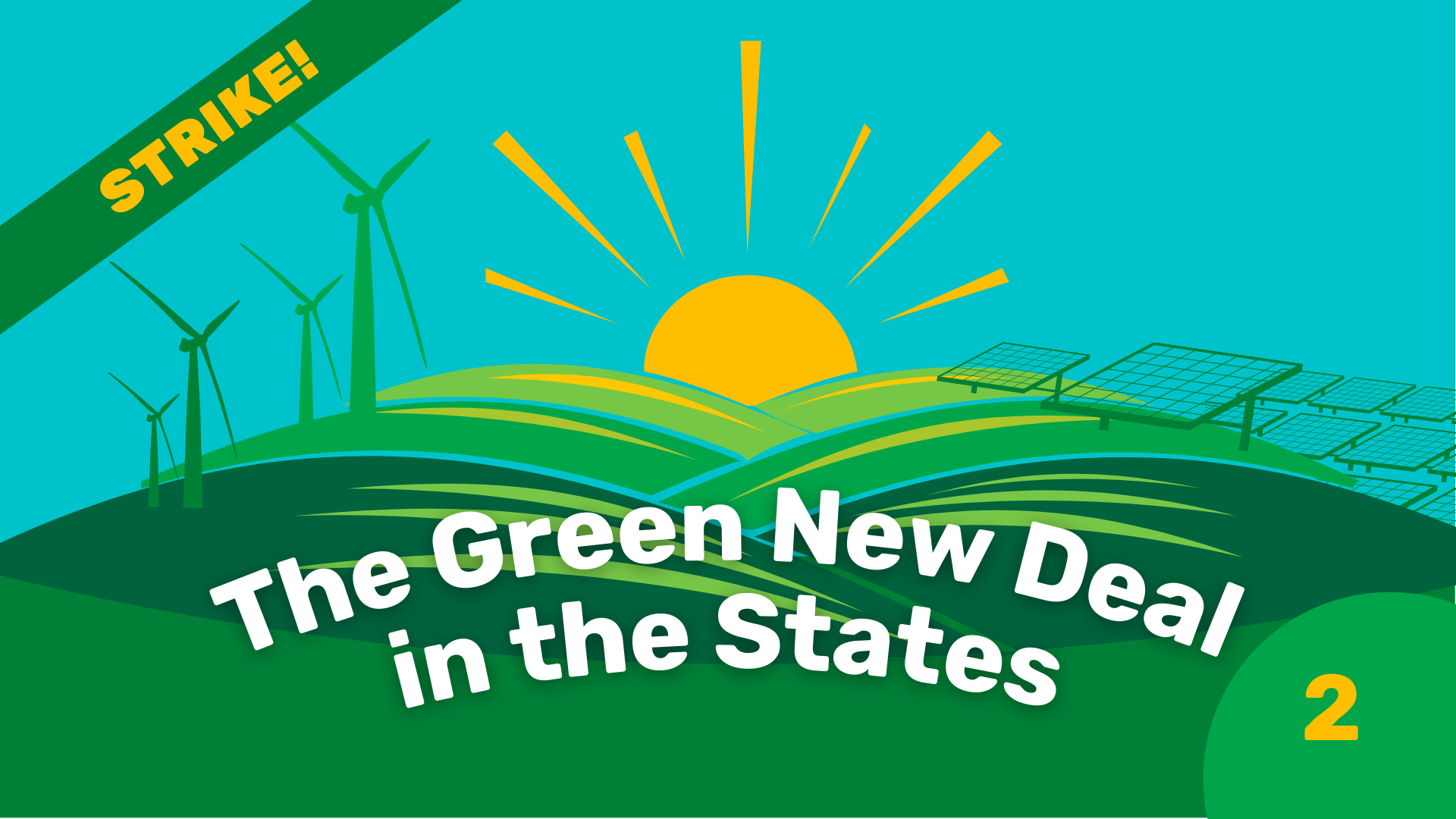As the Green New Deal program has met headwinds in Washington, many states have plowed ahead with efforts to correct injustices and create good jobs as part of programs to fight climate change by reducing greenhouse gas emissions. “The Green New Deal in the States –Part 1” reviewed the climate, jobs, and justice programs in Hawaii and Illinois. This commentary examines the extensive Green New Deal-style programs that California has instituted this year and draws conclusions from the experience of many states.
California: The Summer of Climate Catastrophe – and of Climate Protection
California is the world’s fifth largest economy. Climate change has led to unprecedented heat, drought, wildfires, and other extreme weather conditions that have devasted many parts of the state. Partially as a result, 80% of Californians consider climate change “a serious concern” and 60 percent want to see state-led climate action.
In 1988, just as scientists were confirming the threat of climate change, California mandated an inventory of greenhouse gas emissions. In 2002 it passed vehicle emission standards far exceeding those set by the federal government. In 2006 it passed AB 32, the Global Warming Solutions Act, which required that greenhouse gas emissions be reduced back to 1990 levels by 2020 and established a cap-and-trade program. Subsequent legislation required emissions be cut to 40% below 1990 levels and mandated 60% of all electricity from renewable sources by 2030 and 100% by 2045.[1]
As the deadline for legislation approached on the last evening of August, 2022, the California legislature passed five laws embodying major climate protection and justice measures:[2]
- Restrictions on oil and gas drilling: New oil and gas wells must be set back at least 3,200 feet from homes, schools, and hospitals. Existing wells within the protected zone must meet strict pollution controls, monitor toxic leaks and emissions, install alarm systems, and limit noise, light, dust, and vapors. The bill was labeled a “job killer” by the state Chamber of Commerce and faced fierce lobbying from oil and gas companies and some trade unions.
- Renewable energy: California had already mandated that 60% of its electricity must come from non-carbon sources like solar and wind power by 2030 and 100% — zero emissions — by 2045. The growth of non-carbon energy will need to be sufficient to accommodate an expected 68% increase in energy use by 2045. New legislation requires reaching interim benchmarks: 90% by 2035 and 95% by 2040. All state agencies must source their energy from 100% renewable sources by 2035. Another bill to raise greenhouse gas emission goals from 40% to 55% below 1990 levels by 2030 lost by 4 votes. The state is already struggling to reach the 40% goal.
- Cutting emissions: In 2018 then-governor Jerry Brown signed an executive order requiring the state to be carbon neutral by 2045. New legislation wrote that goal into law. It also required an 85% reduction in GHG emissions from all sources in the state – designed to ensure that carbon neutrality is mostly achieved by lowering emissions, not taking carbon out of the air. It allows meeting the target by offsetting any remaining emissions by planting more trees or such currently unproven technologies as direct air capture.
- Extending Diablo Canyon: The deadline for shutting down the Diablo Canyon nuclear reactors, which provide 9 percent of California’s electricity, was extended for five years and their operator given a $1.4 billion loan to help prevent a shortfall of electrical supply.
- Carbon capture: Legislation directs the California Air Resources Board to set regulations for carbon capture, utilization, and storage projects at oil refineries and other polluting industries. It bans carbon capture from being used to extract more oil – currently its major commercial use. Other legislation requires the state to set targets for removing carbon from the atmosphere with nature-based methods, such as planting trees, restoring wetlands, and scaling up public landscaping and urban forestry projects. What programs will emerge from this process remains to be seen.
Most of these policies were opposed by a coalition of business groups, including the California Business Roundtable and California Chamber of Commerce. They were joined by most building trade unions in a formal alliance called Common Ground which had helped kill previous climate legislation.[3] Common Ground describes itself as “part of a joint labor management committee between the State Building and Construction Trades Council of California and the Western State’s Petroleum Association.”[4] Kevin Slagle, a spokesperson for the oil industry trade group Western States Petroleum Association, characterized the GHG reduction standard as “an extraordinarily aggressive goal that would require large-scale transformation of California’s entire economy.” Such opposition was overcome in part by Gov. Gavin Newsom’s last-minute decision to support the climate bills after staying quiet and not backing them until mid-August.
Gov. Newsom signs climate laws to dramatically cut California’s use of oil and gas | Author: KCRA News | Watch the video »
The end-of-session climate legislation came on top of other climate moves by California government during 2022:
- Food recycling: In January California instituted the largest mandatory residential food waste recycling program in the US to cut down the state’s methane emissions. Californians will toss excess food into green waste bins rather than the trash. Municipalities will then turn the food waste into compost or biogas. The state must cut organic waste in landfills by 75% from 2014 levels by 2025. Grocery stores must donate edible food that otherwise would be thrown away to food banks or similar organizations.
- Beyond fracking and oil extraction: After years of pressure from environmental justice, public health, labor, and climate organizations across California, in April Gov. Newsom announced a ban on new fracking projects by 2024 and directed the California Air Resources Board to analyze pathways to phase out oil extraction across the state by no later than 2045. According to Collin Rees of Oil Change International, this made California the highest-producing jurisdiction in the world to commit to a phase-out of oil extraction.[5] It “sets a vision for a managed decline of fossil fuel extraction,” although it is not realizing that vision “on a timeline necessary to stave off even the worst impacts of climate change.”
- Banning gasoline cars: In August, the California Air Resources Board approved a plan to phase out the sale of gas-powered cars over the next 13 years in America’s largest auto market. The new rule would require zero-emission vehicles to reach 35% of sales by 2026, 68% by 2030 and 100% by 2035.[6] In 2021, only 12% of new cars sold in California were zero-emission.
- Offshore wind: In August, the California Energy Commission adopted a report setting goals for offshore wind of 2,000-5,000 megawatts by 2030 and 25,000 by 2045 — enough electricity to power 25 million homes. The report was developed in coordination with federal, state, and local agencies and stakeholders including Tribal governments, fisheries, and other ocean users. Plans for renovations to prepare for offshore wind activities are already underway at the Port of Humboldt Bay.[7]
- Community solar: Legislation passed in August is likely to unleash a rapid expansion of community solar as a result of a new compensation system. Payment for energy delivered to the grid will now be based on its value at the time it is delivered. This means that community solar projects that are built with battery storage will receive the high price for times of peak demand. The law passed by a broad majority and was backed by solar developers, environmental justice organizations, consumer advocates, the homebuilding industry, and utility workers. At least 51% of subscribers to a project will have to be low-income. Workers must be paid at least prevailing wages.[8]
According to Gov. Gavin Newsom, the new laws will create four million jobs.[9]
In its 2022 budget, California puts a significant amount of money where the state’s mouth is. The budget had a nearly $100 billion operating surplus, primarily due to its high tax rates on its wealthiest residents; the top 1% of earners paid nearly half of personal income-tax collections.[10] The budget includes $54 billion in climate spending over 5 years:
- $6.1 billion for electric vehicles, including money to buy new battery-powered school buses
- $14.8 billion for transit, rail, and port projects
- more than $8 billion to clean up and stabilize the electric grid
- $2.7 billion to reduce wildfire risks
- $2.8 billion in water programs to deal with drought
- $1.5 billion for electric school buses

Los Angeles Skyline With Smog and Smoke | Photo: Chris M, Adobe Stock
At the outset of 2023 Governor Newsom proposed to cut $6 billion from the climate budget he had proposed just months before. Faced with a $22 billion budget deficit, he proposed line-item cuts for electric vehicles, clean energy, wildfire prevention, and programs to help low income residents cope with extreme weather. Other cuts come in programs that would restore wetlands and protect cities from coastal storm surges. Some of the cuts may be restored by funds from the federal Inflation Reduction Act or from an improved budget situation. Months of negotiations are expected before release of a revised budget for legislative action by June 15.[11]
While California’s climate initiatives have received national attention, the state also passed extraordinary labor and social justice policies this summer, making the whole climate-labor-justice package a substantial down payment on a Green New Deal for the state. The budget includes:
- Car-free tax credit: $1,000 refundable tax credit to low-income Californians who don’t own cars. The legislation, the first of its kind in the country, is designed as a reward and an incentive for living car-free.
- Free school meals: In August California established a Universal Meals Program to provide nutritious free meals to all six million public school students – the first state to do so.[12] When the program started at Foussat elementary school in Oceanside, a teacher noticed immediately that “The kids are eating way more and they’re more focused, eager to learn and they’re just happier.”[13]
- Labor rights: The Fast Foods Accountability and Standards Recovery Act provides bargaining rights to the state’s more than half-a-million fast food workers. It establishes a fast food council made up of workers, franchise owners, and franchising companies like McDonald’s which will negotiate employee wages, hours, and working conditions. California fast-food workers have held over 300 strikes over abusive conditions. Industry groups are organizing a referendum to overturn the law.[14] Another new law allows farmworkers to vote to unionize by mail rather than just in person. The United Farm Workers union organized a 335-mile march from Delano to Sacramento in support of the bill. Gov. Newsom initially opposed the bill but at the last minute decided to sign it.[15]
- Housing: Legislation will allow developers to circumvent certain permitting processes in order to build affordable and market-rate housing on underutilized commercial space, described by housing advocates as “monumental” steps to address California’s housing shortage. Other bills will turn underutilized state office buildings into affordable housing, encourage denser housing in cities, and eliminate requirements for parking in new homes built near bus or train stops. A constitutional amendment will be placed on the 2024 ballot that will repeal a requirement that publicly funded affordable housing projects receive voter approval.[16]
Early in 2022 the California Air Resources Board (CARB), which sets climate and air pollution policy in the state, proposed a plan to reduce greenhouse gas emissions by 40% below 1990 levels by 2030. The draft plan was widely criticized as inadequate to address the climate crisis, and Governor Newsome asked the agency to be more aggressive. In November CARB issued the final draft plan — designed to reduce emissions by 48% by 2030. It incorporates the climate legislation passed earlier this year. It commits to build no more natural gas plants. The state estimates it would cut air pollution by 71% and save Californians $200 billion each year in health costs due to pollution, while creating 4 million new jobs. Governor Newsome describes it as “the most ambitious set of climate goals of any jurisdiction in the world” which will spur an “economic transformation akin to the industrial revolution.”[17]
Extensive as these Green New Deal-style programs may be, they are unlikely to be adequate to fully meet the need for either climate protection or for social justice. Nor is it certain what kinds of sanctions there may be for failing to implement policies or realize targets. There will remain plenty of work to be done to ensure the programs are adequate to the need and that they are realized in fact.
California still has plenty of room for additional Green-New-Deal-style programs. Ellie Cohen, CEO of policy nonprofit The Climate Center, and UC Berkeley professor Dan Kammen have argued that California’s 2030 target should be at least 55% below 1990 levels and that it should not rely on “failed and expensive” carbon capture technologies.[18] A proposal that would have required corporations with revenues of more than $1 billion to disclose their greenhouse gas emissions failed to pass the Assembly. So did a proposal from the Green New Deal California Coalition for a “Justice40” policy that would have required California to invest at least 40 percent of federal climate and infrastructure funding in communities that have been historically neglected by discriminatory and racist policies.[19]
Laboratories of the Green New Deal

Justice Louis Brandeis famously called the states laboratories of democracy. Today they are serving as laboratories of the Green New Deal.
Many states in addition to the three we have described in this and the preceding Commentaries are implementing Green New Deal-style plans for expanding jobs and justice by reducing greenhouse gas emissions to protect the climate. For example:
- New York: The 2019 New York Climate Leadership and Protection Act requires net-zero carbon emissions by 2050. It includes a Just Transition Working Group to address workforce development and job creation and a Climate Justice Working Group to address the needs of low-income and minority communities.[20] A draft scoping report laying out detailed strategies for reaching these goals was issued January 1, 2022.[21]
- Mississippi: In July 2022 Mississippi passed a set of rules subsidizing rooftop solar, including rebates for low- and middle-income customers, incentives for school solarization, and net metering. Keith Johnston, a senior attorney at the Southern Environmental Law Center, said Mississippi is encouraging rooftop solar because “it benefits low, moderate income households, and it benefits customers generally and the grid generally.”[22]
- Maine: In 2019 Maine passed legislation that increased its Renewable Portfolio Standard to 80% by 2030 and set a goal of 100% by 2050. It also passed a Green New Deal Act that requires construction of grid-scale power generation to employ people from an apprenticeship program and provides solar installations on newly built schools.
State initiatives include an impressive range of Green New Deal policies. On the climate side these include shutting down fossil fuel facilities, building new fossil free energy systems, and forms of energy efficiency ranging from low-emission building standards to electrification of vehicles to reduced energy demand. Expanded labor rights and standards include requirements for prevailing wages, project labor agreements, and employer neutrality on union representation. Policies to counter historical injustices range from recruitment, training, and job ladders for workers from discriminated-against demographics to priority for closing power plants in highly polluted climate justice communities. Just transition measures range from investment in communities impacted by climate policies to transition assistance for workers to requiring employers to provide preferential employment opportunities for affected employees. Associated social welfare measures have ranged from free meals for all public school students to low-emission low-income housing to job training centers in low-income neighborhoods.
Of course, not all “Green New Deal states” have adopted all of these policies, and some states have actively rejected them. Alabama, for example, deliberately discourages solar installations by allowing its largest utility, Alabama Power, to charge a fee averaging $27 a month for customers with rooftop solar. (Not surprisingly, Alabama rates 49th among US states in solar installations.)[23] Missouri, Ohio, Alabama, Arkansas, Georgia, Indiana, Kansas, Kentucky, Louisiana, Mississippi, Montana, Nebraska, Oklahoma, South Carolina, Texas, Utah and West Virginia have gone so far as to sue the federal government for allowing California to ban the sale of new gasoline-powered cars.[24]
There are also constitutional limitations on what states can do. For example, national transportation and grid planning are difficult for states to determine, even when they cooperate across state boundaries. And almost all states are blocked by their own constitutions from the kind of deficit spending that multiplies the financial power of the federal government.
While the powers states can exercise in our federal system may appear constitutionally limited, in fact those limits are highly flexible, and states can engage in many kinds of radical action if there is a supportive political context. Before and during the New Deal states established their own bank deposit insurance systems; created publicly owned utilities; imposed mortgage moratoriums; and banned injunctions against strikes. These programs might have seemed beyond the jurisdiction of states just a few years earlier. Similarly, Green New Deal from Below programs can be creative in utilizing all the potential powers of state government.
The political dynamics that lie behind these state results vary considerably. In Hawaii, a broad consensus supported the transition away from fossil fuel energy, and the main concern was how to mesh fossil fuel cutbacks with the necessary expansion of renewable energy. In Illinois, environmental justice, labor, renewable energy developers, and utility interests battled over the content of a climate protection bill. The positive outcome resulted from the decision of pro-climate protection forces to ultimately support each other’s programs while the utility industry was largely sidelined as a result of scandals that marginalized it and some of its leading political supporters.[25] In California, devastating effects of climate change multiplied popular support for strong action; a large short-term budget surplus facilitated massive climate spending; and the last minute-decision of the governor to back a raft of legislative climate initiatives swung the balance to passage.
State climate protection efforts go beyond the geographical limits of the US. When President Trump announced US withdrawal from the Paris Climate Agreement, the governors of New York and California initiated the U.S. Climate Alliance and pledged to comply with the Paris Agreement. The alliance now includes 24 states that are committed to:
- Reducing collective net GHG emissions at least 26-28 percent by 2025 and 50-52 percent by 2030, both below 2005 levels, and collectively achieving overall net-zero GHG emissions as soon as practicable, and no later than 2050.
- Centering equity, environmental justice, and a just economic transition in their efforts to achieve their climate goals and create high-quality jobs.
California, Maine, Massachusetts, Oregon, Rhode Island, and Washington are also part of the Under2 Coalition which brings together over 270 sub-national governments representing 1.75 billion people and 50% of the global economy committed to climate protection policies.[26]
Creating a just, prosperous, and climate safe economy requires multiple changes in every aspect of society. The Green New Deal involves just such a comprehensive transformation. The range of programs and policies emerging in Green New Deal-style programs at the state level are beginning for the first time to embody such breadth and complexity of change. If all the elements in the state Green New Deal-type actions were brought to scale and spread to other states and other levels of government it would be the basis for a transition to climate safety, good jobs for all, and a far fairer, more equal society.
[1] Daniel Farber, “State Governmental Leadership in U.S. Climate Policy,” Wilson Center, June 23, 2021. https://www.wilsoncenter.org/article/state-governmental-leadership-us-climate-policy
[2] Unless otherwise noted, this account is based on Brad Plumer, “California Approves a Wave of Aggressive New Climate Measures, New York Times, September 1, 2022. https://www.nytimes.com/2022/09/01/climate/california-lawmakers-climate-legislation.html; Kathleen Ronayne, “California Democrats Cap Legislative Year with Climate Wins,” NBC Bay Area, September 2, 2022. https://www.nbcbayarea.com/news/california/california-climate-wins/2992599/ ; Nadia Lopez, “California approves big climate change steps – but one ambitious one fails,” CalMatters, September 1, 2022; updated September 16, 2022. https://calmatters.org/environment/2022/09/california-climate-change-legislature/
[3] Emily Pontecorvo, “How a debate over carbon capture derailed California’s landmark climate bill,”
Grist, December 15, 2021. https://grist.org/politics/carbon-capture-why-california-cant-fill-the-net-zero-gap-in-its-climate-strategy/
[4] https://commongroundca.org
[5] Collin Rees, “California becomes largest oil producer in world to commit to total oil phaseout, ban fracking — but not soon enough,” Oil Change International, April 23, 2022. http://priceofoil.org/2021/04/23/last-chance-alliance-california-fracking-oil-phase-out/
[6] Dani Anguiano, “California bans sales of new gasoline-powered vehicles by 2035 in milestone step,” | Guardian, August 25, 2022. https://www.theguardian.com/us-news/2022/aug/24/california-ban-sales-gas-powered-cars-2035
[7] “CEC Adopts Historic California Offshore Wind Goals, Enough to Power Upwards of 25 Million Homes,” HomeNewsroom, August 10. 2022. https://www.energy.ca.gov/news/2022-08/cec-adopts-historic-california-offshore-wind-goals-enough-power-upwards-25
[8] Julian Spector, “California is finally unlocking community solar for the masses,” Canary Media, September 8, 2022. https://www.canarymedia.com/articles/solar/california-is-finally-unlocking-community-solar-for-the-masses
[9] “Governor Newsom Signs Sweeping Climate Measures, Ushering in New Era of World-Leading Climate Action,” September 16, 2022. This release includes a list of 40 climate-related bills passed by the legislature and signed by the governor in 2022. https://www.gov.ca.gov/2022/09/16/governor-newsom-signs-sweeping-climate-measures-ushering-in-new-era-of-world-leading-climate-action/
[10] Romy Varghese, “California Sees Record $97.5 Billion Surplus, Driven by the Rich,” Bloomberg, May 5, 2022, updated May 13, 2022. https://www.bloomberg.com/news/articles/2022-05-13/california-governor-sees-record-97-5-billion-operating-surplus
[11] Maanvi Singh, “California governor caught in eye of storm over climate budget cuts,” Guardian, January 12, 2023. https://www.theguardian.com/us-news/2023/jan/12/california-governor-gavin-newsom-climate-budget-cut
[12] Kelly McCarthy, “California becomes 1st state to offer free meals at school for kids,” Good Morning America, August 12, 2022. https://www.goodmorningamerica.com/food/story/california-1st-state-offer-free-meals-school-kids-88290584
[13] Victoria Namkung, “‘The kids are just happier’: could California’s universal school meal program start a trend?” The Guardian, September 26, 2022, https://www.theguardian.com/environment/2022/sep/26/free-school-meals-california-universal
[14] Michael Sainato, “California’s fast-food industry calls for referendum on new labor legislation,” The Guardian, September 18, 2022. https://www.theguardian.com/us-news/2022/sep/18/california-labor-law-fast-food-industry-referendum
[15] Chris Nichols, Nicole Nixon, Kris Hooks, “Here are the major bills passed by California lawmakers in 2022,” capradio.org, September 1, 2022. https://www.capradio.org/articles/2022/09/01/here-are-the-major-bills-passed-by-california-lawmakers-in-2022/ ; Ashley Zavala, “Gov. Newsom signs bills to turn unused retail areas into housing,” KCRA, September 28, 2022. https://www.kcra.com/article/gov-newsom-to-sign-bills-to-turn-unused-retail-areas-into-housing/41427984#
[16] Chris Nichols et al., Ibid.
[17] Kevin Stark, “California Releases Sweeping New Climate Action Plan to Reach Carbon Neutrality,” November 16, 2022. KQED https://www.kqed.org/science/1980792/a-roadmap-to-carbon-neutrality-california-releases-sweeping-new-climate-action-plan
[18] Ellie Cohen and Dan Kammen, “Two fixes to bolster California’s new climate blueprint,” CalMatters, November 11, 2022. https://calmatters.org/commentary/2022/11/california-climate-air-resources-board-scoping-plan/
[19] “Isaac Bryan Introduces Bill to Achieve Justice40 in California for Historically Underfunded Communities,” California Green New Deal Coalition, February 17, 2022. https://greennewdealca.org/news/isaac-bryan-introduces-bill-to-achieve-justice40-in-california-for-historically-underfunded-communities/
[20] Lissa Harris, “In a World of Vague Climate Targets, New York Has a Plan – Almost,” River Newsroom, November 19, 2021.https://therivernewsroom.com/climate-action-council-draft-scoping-plan/
[21] “Climate Action Council Scoping Plan,” New York State, January 1, 2022. https://climate.ny.gov/Our-Climate-Act/Draft-Scoping-Plan
[22] Dennis Pillion, “Mississippi opts to encourage solar panels, as Alabama fights to keep solar fee,” al.com, July 16, 2022. https://www.al.com/news/2022/07/mississippi-opts-to-encourage-solar-panels-as-alabama-fights-to-keep-solar-fee.html
[23] Dennis Pillion, Ibid..
[24] Kurt Erickson, “As California moves ahead on electric vehicles, Missouri, other states try to pull plug,” stltoday.com, August 25, 2022. https://www.stltoday.com/news/local/govt-and-politics/as-california-moves-ahead-on-electric-vehicles-missouri-other-states-try-to-pull-plug/article_6d990642-156f-57ed-8b51-3563189c4e7b.html
[25] David Roberts, “Illinois’ brilliant new climate, jobs, and justice bill,” Volts, September 22, 2021. https://www.volts.wtf/p/illinois-brilliant-new-climate-jobs
[26] Daniel Farber, “State Governmental Leadership in U.S. Climate Policy,” Wilson Center, June 23, 2021. https://www.wilsoncenter.org/article/state-governmental-leadership-us-climate-policy For U.S. Climate Alliance see http://www.usclimatealliance.org For Under2 Coalition see https://www.theclimategroup.org/under2-coalition


